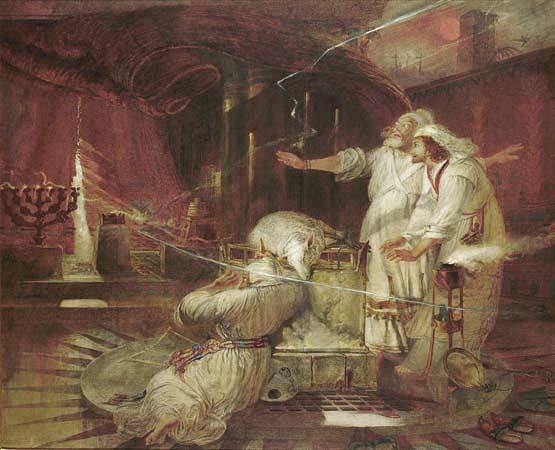While the sun’s light failed…the curtain of the temple was torn in two (Lk.23:45).
Palm Sunday begins our observance of Holy Week, the Week of Salvation. The reading of Our Lord’s Passion places us at the foot of the cross with Our Lady and Our Lord’s most faithful disciples. In them we recognise the first gathering of a faithful remnant (Cf. Rom. 11:5); and from them we endeavour to learn to remain steadfast in the truth of Christ, no matter the worldly consequences. Every detail recorded by the evangelists serves for our instruction. While the sun’s light failed…the curtain of the temple was torn in two (Lk.23:45). This veil was forty-five feet in length and four inches thick. It served as the barrier to the Holy of Holies, where God’s presence rested and where the Ark of the Covenant was kept. Its rending from top to bottom is an act of God meant to convey a deeper truth that can be accessed only through faith in Jesus, the Son of God, Our Saviour and High Priest.
To understand what the Passion of Our Lord has effected and continues to effect in the world today, we must leave the elementary doctrine of Christ and go on to maturity (Heb. 6:1). In other words, we must not be content simply to recall His Passion; we must enter into this Mystery with a desire for deeper understanding. The veil has been rent because we have access to God through Christ Our Saviour. Therefore, brethren, since we have confidence to enter the sanctuary by the blood of Jesus, by the new and living way which he opened for us through the curtain, that is, through his flesh (Heb. 10:19-20). Our Lord, because He shares our human nature, has opened for us and for all humanity a way to God through His sacred humanity. The flesh that is offered in sacrifice for our salvation is like our flesh for He became as we are, yet without sin (Heb. 4:15). There is no longer any need for the sacrifices of old because Jesus our High Priest has sacrificed Himself; and on the Altar of the Cross He is both Priest and Victim. The curtain of the temple, the first veil, is torn from top to bottom because now, through faith in Christ all have access to God through the Sacrifice of His Son. We must pass through the first veil and approach the second, turning our eyes toward the Holy of Holies (St. Gregory Nazianzen). The second veil is the veil of His flesh; as we gaze on Him who was pierced for our transgressions [and] crushed for our iniquities (Is. 53:5) the prophecy of Zechariah is fulfilled; and we look on him whom they have pierced (Jn. 19:37).
We desire then to enter into the Mystery of Our Lord’s sacred Passion and in so doing, to come to a fuller understanding of God and of ourselves for it was for our sake that Our Lord became obedient unto death, even death on the cross. This deeper understanding however will evade us without a personal expression of love for Our Saviour. What good would life be to us without our knowledge of Christ Jesus the Saviour? The gift of love enables us to become in reality what we celebrate as mystery in the sacrifice (Fulgentius of Ruspe, Liturgy of the Hours, Vol. IV, p. 379). These words explain and expand the declaration of the Apostle Paul: I have been crucified with Christ; it is no longer I who live, but Christ who lives in me; and the life I now live in the flesh I live by faith in the Son of God, who loved me and gave himself for me (Gal. 2:20).
If this Mystery of salvation is to be effective in our lives, then we must be willing to be one with Christ Our Lord in the firm conviction that our own sufferings borne because of our fidelity to Him, our witness to His truth in the face of evil and deception, and our lives of sacrificial love are as needed in our time as they always have been. We commemorate the mysteries of our salvation in union with Our Lady, the Mother of Mercy and we implore her intercession so that we might with loving minds and hearts come to a deeper love for Jesus Crucified, who is at once priest and sacrifice, God and temple. He is the priest through whom we have been reconciled, the sacrifice by which we have been reconciled, the temple in which we have been reconciled, the God with whom we have been reconciled (Fulgentius of Ruspe, Liturgy of the Hours, Vol. II, p. 383-84).


